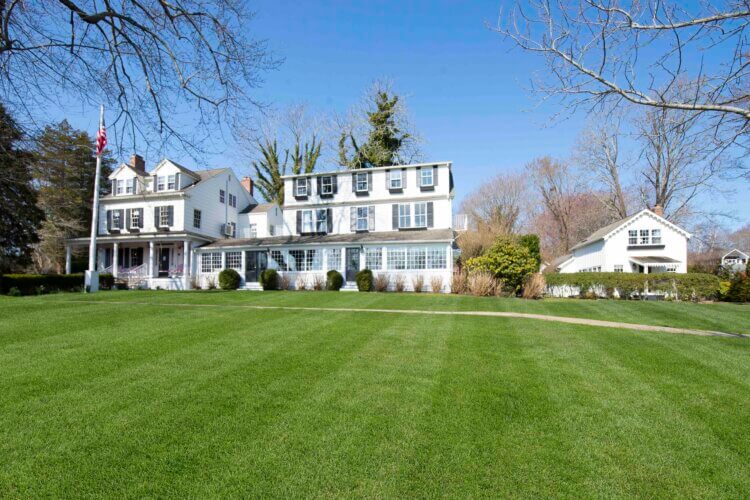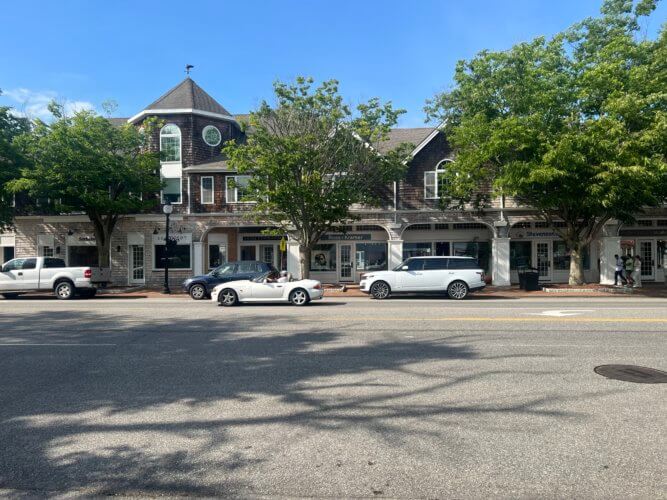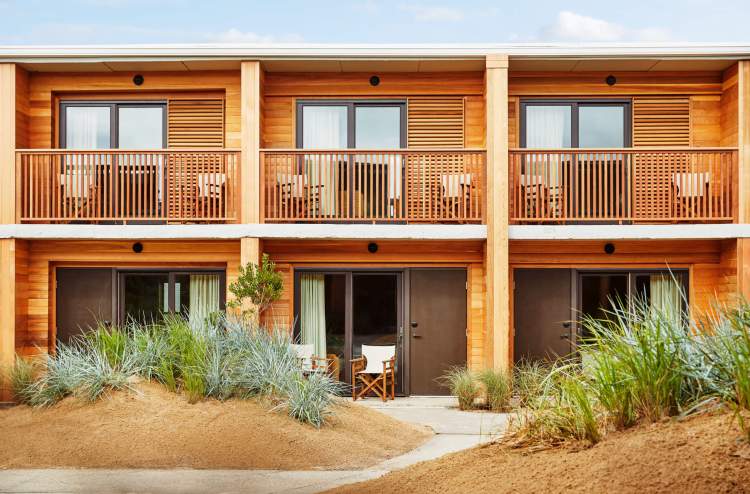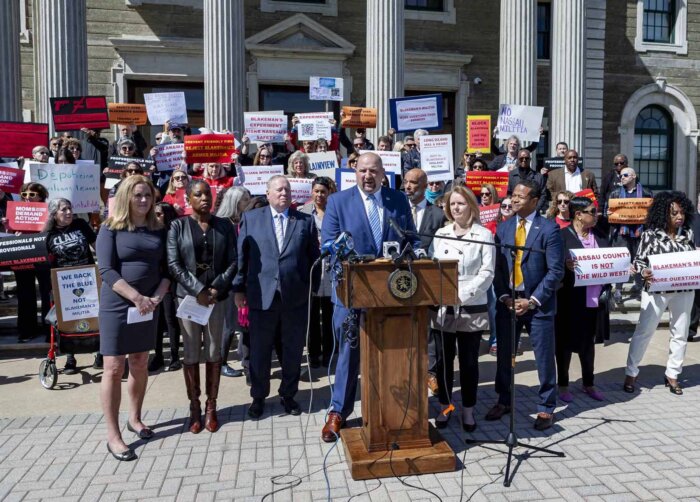While residential real estate has slowed from the feverish pace of the COVID-19 pandemic, commercial sales have been making headlines in recent weeks.
The designer Elie Tahari and his son sold a prominent building in East Hampton Village for $22 million last month for more than three times what Tahari paid in 2006. The buyer was Bernard Arnault, the chairman and CEO of the French conglomerate LVMH Moët Hennessy Louis Vuitton and who is, according to Forbes, the richest person in the world.
Not only was this the highest price per square foot for any single-tenant building in East Hampton, but the trade also set the record price per square foot for any building on Long Island, according to Dan Abbondandolo, executive director at Cushman & Wakefield, the global real estate services firm that facilitated the sale of 1 Main Street.
“East Hampton Village has become the new Rodeo Drive as far as commercial retail space goes,” says Tony Cerio of the Cerio Natter Team at Brown Harris Stevens, who, along with Mitch Natter and Jared Schiavoni, represented the buyers who purchased the village’s iconic Maidstone Hotel earlier this month.

“The day of the mom-and-pop operation is long gone for the most part. Every major luxury brand wants to be here, and they are willing to pay premium prices for having an East Hampton location as part of their brand identity,” Cerio says.
Last summer, the village saw several new, high-end designer boutiques, including Valentino, Chanel and Prada, open.
“The influx of luxury brands is not only a strategic real estate move, but a critical marketing and branding opportunity,” says Abbondandolo, pointing to a recent study that showed the personal luxury goods market posted remarkable growth across the country in 2022, which many believe will continue into this year.
The surge in East End residential sales during the COVID-19 pandemic, “provided clear data that people are spending more time out east on a more permanent basis,” he adds.
Investors familiar with a particular brand or industry “are always looking to complement their portfolio,” he says. “A majority of landlords on the East End own similar assets in comparable markets such as Greenwich, Connecticut, downtown Boston and prime Fifth Avenue (real estate) in New York City.”
The commercial market is active thanks to the “pandemic exodus from the city” that created a more year-round environment, thus giving a boost to restaurants and retail, says Lee Minetree, a broker at Saunders & Associates.
The sale of the Tahari building in East Hampton “is definitely important for the local market in that it was three times the average price per square foot from the average retail sales in the village,” Minetree says. Coupled with the lack of retail spaces for lease, he believes it will result in higher rents in East Hampton Village. “There was a space available on Newtown Lane this year, and in short order there were over 14 offers on the property,” he says. ‘This was a much smaller property but the price was $250 per square foot!”
Hal Zwick of Compass Commercial, who, with his partner Jeff Sztorc, is among the top producing commercial real estate brokers in the Hamptons — handling deals such as the $28 million sale of a building on East Hampton’s Newtown Lane in 2022 — agrees the market is very strong. They weren’t sure what to expect in 2023, but the first quarter has proven better than they thought it would be.
Still, they caution that the $22 million sale was an anomaly that occurred because the buyer is an end-user and one of his luxury brands will occupy the space.
Real estate that houses retail establishments has experienced a bit of a slowdown due to interest rate rises, according to Zwick, adding that hospitality, industrial and restaurant real estate has been strong.
“I think our market on the commercial side is more transactional than the residential side right now, just because there’s people that are looking for opportunities, new players that have come to the market during the pandemic and have seen some good investment opportunities. But, it depends on the category,” Sztorc says.
“We have some new players, as Jeff said, that have come in — a new, younger, more aggressive development group,” most of whom have houses on the East End, Zwick adds. “They know that they might not get as good a buy as they might get in Westchester or New Jersey or someplace else now, but they see the long-term potential and how prices rise here.”

Impact of Rate Hikes
“Historically, the commercial sector lags behind residential,” Abbondandolo says. “Residential sales have a much shorter pipeline, allowing the market to react quicker to shifts in demand. The increase of rates will impact commercial real estate, however, premier East End real estate has proven to be resilient year after year.” He adds, “Entitling commercial sites for new development is a multiyear process, creating a frothy premium for existing assets in desirable pockets.”
Affluent and high-net-worth investors still gravitate here, of course. “The demand and exclusivity of the area have appreciated the assets in the village, bringing higher rent prices and sales prices.”
Still, interest rates directly impact cap rates, the expected rate of return on a real estate investment property, and this drives value, Abbondandolo says. “That said, the typical investor in high-end downtowns are generally all cash buyers — insulated from interest rate volatility.”
But not all buyers are looking to do cash deals.
“Basically, if people were paying 4% for a commercial mortgage two years ago, which was pretty standard, and now it’s 7%,” Zwick explains. “When they were paying 4%, they were willing to buy properties that would give them a 5% return on their investment. But if they’re paying 7% interest, they’re not going to buy properties that only give them a 5% return on their interest — they want at least 6% or 7% return in their interest — that’s the issue.
“Most commercial property owners don’t need to sell,” he continues. When interest rates went up and it looked like prices would have to come down, many just said they would wait to sell until they come back down — “and people do expect them to come down before the election in ’24.”
The difference could be as much as $500,000 to $2 million, depending on the value of the building or the property.
Others see opportunity. “Sellers are saving deals in the face of this financial … whatever you want to call it … by allowing, accepting seller financing, seller mortgages,” Sztorc adds.
“If a seller of the commercial property can wrap their head around trusting a buyer and giving them a seller note, they’ll make more money in the long run and they’ll get a deal to happen that otherwise might be on hold for a couple years.”
Cerio agrees. “The banks’ requirements are stringent, and the rates are higher than they have been in years, but in the commercial real estate world there tends to be a lot of money available that makes direct financing an attractive option,” he says. “We are also seeing a lot of cash buyers as well as investors that are looking beyond New York City because the returns here are growing rapidly.”
In comparison, on the residential side there is low inventory in the post-pandemic market. “Homeowners who bought at record low-interest rates are hesitant to sell just to pay higher rates on a new home,” Cerio says. “Many agents will tell you that interest rates don’t matter as much here because of the number of cash buyers. Often overlooked in the highend market is the fact that many buyers would make an all-cash offer in order to secure the deal, but would get a mortgage after the closing. When interest rates were low it was a smart move to invest that money elsewhere. As interest rates climb, that is not as attractive.”
“There is no comparison to our market right now,” he adds.
Blue Flag Partners made a $13.5 million investment in what was briefly called Sunrise Beach Hotel in Montauk Harbor. It will reopen this summer as Sunset Montauk. The deal closed in December.

In the Hamptons, inventory is always going to be at a premium.
“There’s still less and less commercial inventory,” Zwick says. “Remember there’s been a lot of residential inventory built over the last 10 years, over the last five years, over the last two years. There really has not been new commercial inventory built. So the inventory is less, and the demand has remained the same.”
“The Hamptons market, and the commercial sector in particular, stays strong because of supply and demand,” says Cerio. “Throughout any market fluctuation, this region will always be a magnet for luxury homebuyers and the attendant luxury commercial market. We have seen the commercial market here, in all of the villages and towns, only gain in strength over the past few years, whether you are looking at retail or hospitality or services such as marinas.”
One example, EHP Hospitality Group, a rapidly growing collection of resorts, marinas and restaurants in the Hamptons, expanded, making it one of the largest marina owners and operators on Long Island, offering nearly 500 boat slips in total. The hospitality group, which began with the EHP Resort & Marina in East Hampton and Shagwong Marina a half-mile away on Three Mile Harbor three years ago, has since added Shagwong Marinas in Hampton Bays, New Suffolk and Cutchogue to its portfolio.
The health of the inventory level right now depends on the category examined.
“But due to that activity, there are fewer than normal retail and restaurant leases available,” Minetree says. “Also, with restaurants doing so well fewer restaurants are selling.”
The hospitality market is also lacking inventory as many properties have traded in recent years, such as the Bentley Hotel and the Atlantic hotel in Southampton, the Wainscott Inn in Sagapoanck and, most recently, the Montauk Yacht Club.
Retail inventory is low, though not as low as it was during the peak of the pandemic, Sztorc says, but quality retail is historically low. “Industrial? The inventory’s still low. When you get into that niche off-market asset category, hospitality, it’s almost like there’s no such thing as inventory.”
Office inventory is high, of course. “People are not looking for large office space. What’s going on is people want individual offices or one- or two-room suites,” Zwick says.

What’s Ahead
What is in demand is medical offices. “That is the only category that is looking for large office space because (medical groups) do see a void out here as far as medical coverage. Stony Brook saw that a number of years ago — they opened the cancer center, they opened the cardiac center. Northwell and Weill-Cornell have followed.”
Farrell Builders recently put up a sign that it plans to build a 15,000-square-foot medical building next to Burger King on County Road 39 in Southampton.
There’s also a shift occurring because of Stony Brook Southampton Hospital’s future plans. The hospital plans to move from Southampton Village to the Stony Brook Southampton College campus on County Road 39 in Shinnecock in the next three to five years.
“That whole Meeting House Lane complex is starting to empty out because the reason that those physicians were over there was to be adjacent to the hospital. There’s a lot more demand further down, further west towards the Stony Brook campus,” Zwick says.
Then in East Hampton, where construction is underway on the new 22,000-square-foot satellite emergency room facility at 400 Pantigo Place, there is a demand for doctors’ offices in the area.
Email tvecsey@danspapers.com with further comments, questions, or tips. Follow Behind The Hedges on Twitter, Instagram and Facebook.




















